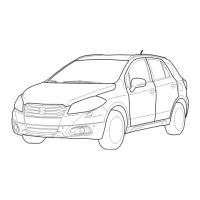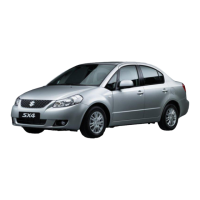EXHAUST GAS RECIRCULATION
(EGR)
SYSTEM
This system controls the formation of NOx emission by recirculating the exhaust gas into the combustion
chamber through the intake manifold.
The diaphragm mounted in the EGR modulator is operated by back pressure of the exhaust gas to open
and close the valve. By this opening and closing action of the valve, the EGR modulator controls the
vacuum transmitted to the EGR valve.
Under a low load condition such as low speed driving, the exhaust pressure is low. In this state, the dia-
phragm in the EGR modulator is pushed down by the spring force and the modulator valve opens to allow
the air into the vacuum passage from the outside.
As a result, the vacuum transmitted to the EGR valve becomes smaller and so does the opening of the
EGR valve. Thus, less amount of exhaust gas is recirculated to the intake manifold.
Under a high load condition such as high speed driving, on the other hand, the exhaust pressure is high. By
the high exhaust pressure, the diaphragm in the modulator is pushed up and closes its valve. As the air
does not enter the vacuum passage in this state, the vacuum transmitted to the EGR valve grows larger
and so does the opening of the EGR valve. Thus, larger amount of exhaust gas is recirculated to the intake
manifold.
Under any one of the following conditions, the vacuum passage is closed by the TWSV or BVSV and the
vacuum is not transmitted to the EGR valve which, therefore, doesn’t operate.
l When the coolant temperature is low. (BVSV is closed)
l When the gear shift lever is shifted to fifth gear position and fifth switch is turned on. (TWSV is closed)
l When HAC is turned on. (TWSV is closed)
Other than the above, EG
R
valve opens and closes in accordance with the EG
R
modulator operation.
8
c
,
1.
EGR modulator
10
2.
EGR valve
3.
8VSV
J
4. intake manifold
5. Diaphragm
6.
Valve
7.
Filter
8. HAC
9. Fifth switch
10. ECM
e
Fresh air
-
Vacuum
11. Battery
@!B Exhaust gas
*---Air
12. TWSV
Fig.
5-l-
17
EGR system operation
5-14

